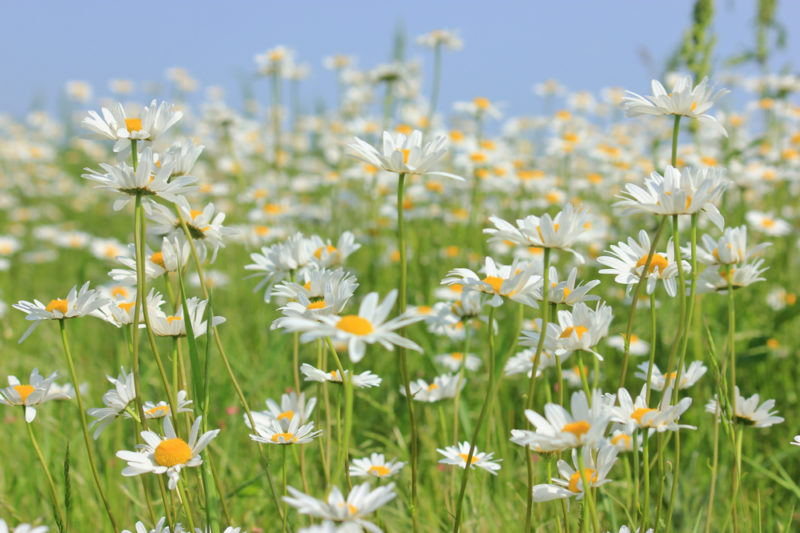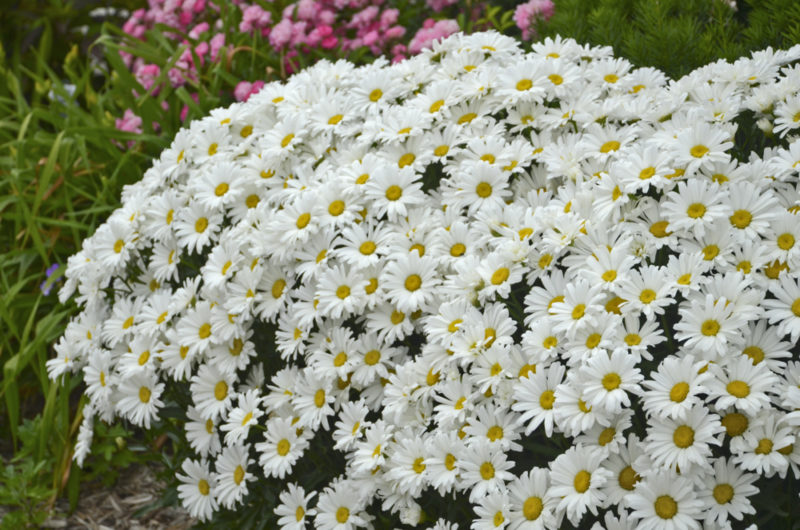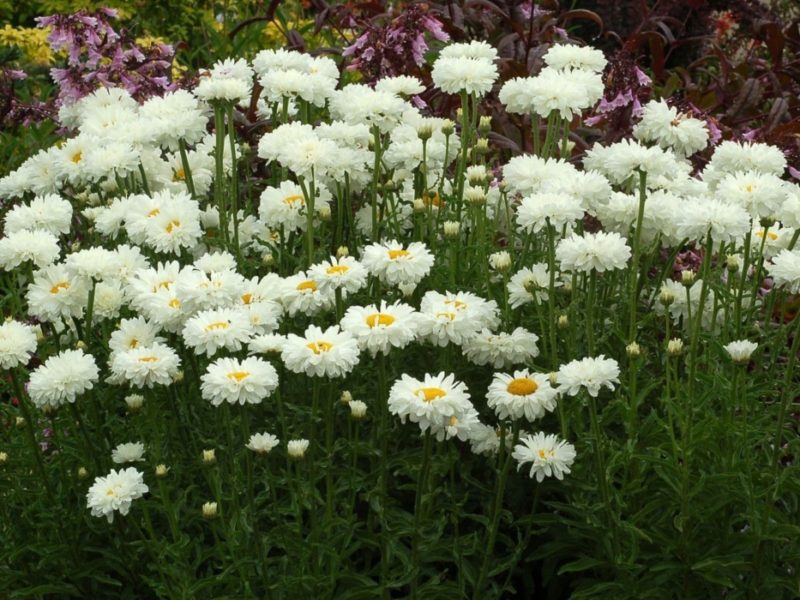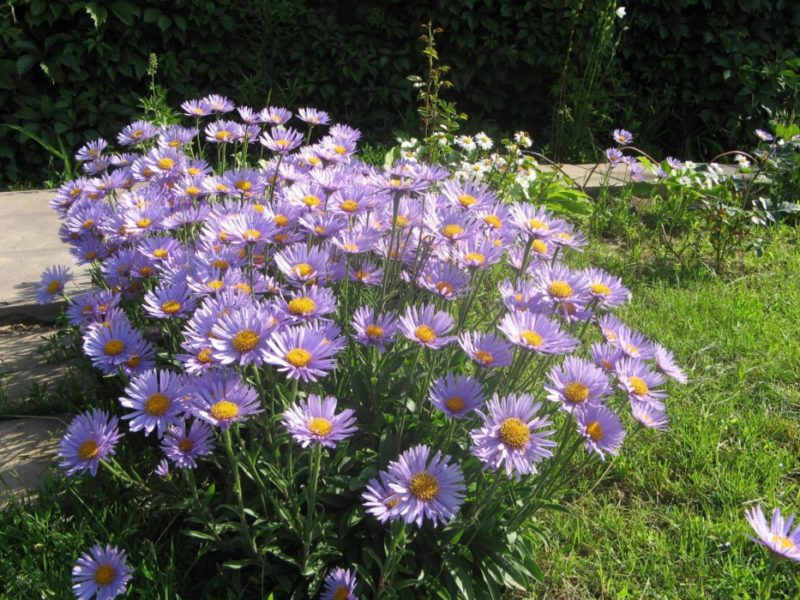Leucanthemum vulgare is a very attractive plant. Not only with its beauty it attracts a person, but also with useful properties. Many people, seeing a flower, say that it is a camomile. By no means, this is another plant, and we will consider the differences in this article. And also learn how to grow a nyvyanik on your site, about the benefits of the species.
Material Content:
View description
Common clergyman belongs to the large Astrov family, genus nivyanik. Its name in Latin is Leucanthemum vulgare, which means “white flower”. The plant is perennial.
Outwardly, the nyvyanik is familiar to everyone, because it is found everywhere in our country - in meadows, fields, along roads. The genus of the plant is not too rich, it includes only 20 species, the common nimbus is one of them, and we will consider it.
The stalk is straight, almost does not branch, can be of different lengths - from 20 to 130 cm. Inflorescences in the form of baskets appear on it and bloom with beautiful flowers, their petals are white and the middle is yellow. At the root, the plant forms a rosette, which is framed by an unsightly type of foliage - dark green, narrow, oblong, the edges are slightly ribbed, in some species it is only below, near the ground, in others it is rare, but it is found throughout the stem. The root of the arena is fibrous, rather short.
Particular attention should be paid to inflorescences, they reach 3-6 cm in diameter, consist of two types of flowers - in the center there are short tubular yellow colors, and large reed, pure white frames around the edges (we take them for petals).Long flowering, begins in late May, ends in late July, and even in mid-August.
Breeders could not ignore such a beautiful plant, and bred certain varieties for cultivation in the garden.
We offer a brief look at the most interesting specimens:
- Maxima Kenig - differs in large inflorescences, their diameter can be 12 cm. Reed white color are arranged in two rows, and the central tubular have a dark yellow color. Stem up to 1 m high. Flowering plant will delight one and a half months starting in mid-June.
- May Queen - the plant is not the highest of the species, the height of the bush varies between 35-50 cm. The leaves are glossy, shine in the sun, form a thick rosette. Inflorescence baskets of small diameter, 5-8 cm each.
- San-Souci - height is up to 1 m. The plant is very beautiful, here the white reed flowers are arranged in 8 rows, with a fluffy skirt-bundle framed by a bright yellow center.
Due to the external similarity, the plant is confused with chamomile, the differences from it are as follows:
- Leucanthemum flowers are larger.
- The leaf of an vernus is whole, dense, while chamomile is thin, dissected into many small leaves.
- There is always one inflorescence on the stalk of a nyvnik In chamomile, the stem branches, forming one from many, and each has an inflorescence.
- Leucanthemum is a perennial, and chamomile is an annual plant.
So, just by looking closely, you can easily distinguish these two plants from each other.
Where does the common Leucanthemum grow
The most common plant in Europe (south and central part). And also a nyvyanik grows in Australia, in Asia, in New Zealand, North America, on Sakhalin and the Kuril Islands.
The flower does not require special conditions for growth, therefore it is widespread. It can be seen at the edges, in the fields, it covers the glades. In the forests, the plant does not feel very comfortable because of the insufficient amount of sun.
Growing Features
Like any flowering crop, meadow novyanik is very demanding on the composition of the soil. It should be fertile, light, breathable, with drainage.
It is better to grow flowers in the open space, where sunlight will come in large quantities. In the shaded area, the leucanthemum will also grow, but still the quality of flowering and the size of the bush will undergo changes.
The plant does not tolerate wetlands, damp areas. Therefore, it is recommended to plant an vernus in the open ground for the first time in the form of seedlings. In the future, the plant itself will grow, and next year you will notice the replenishment in the flowerbed.
If you chose to cultivate a nyvnyak from seeds immediately on the bed, then follow the following instructions:
- Prepare the soil, it is necessary to add humus, lime - if the soil is acidic. All these procedures can be performed in advance in the fall or early spring, when the ground thaws.
- It is better to sow after the summer season, in September-October, when the soil is warm, but not enough for the seeds to sprout.
- If you chose a spring planting, then wait until the soil warms up, and the average daily temperature reaches +10 degrees.
- Make holes in the beds or grooves, place the seeds at a distance of 5 cm from each other.
- When the planting has reached a height of 5 cm, they need to be thinned out so that there is no thickening.
- Pour. In the autumn, there will be enough rainwater, and in the spring, water so that the soil is stably moist, but not swampy.
Seedling method:
- 2 months before the alleged planting of the plant in open ground, you need to start growing seedlings.
- Prepare peat pots or jars (box) with garden soil. Pour.
- Seed the seeds in moist soil, cover with foil, place in a warm, dark place. Maintain humidity, remove the film once a day for 2-3 hours, so that the soil does not become moldy.
- After 7-10 days, the first sprouts will hatch. Remove the film, and place the seedlings on the windowsill, where there is more light.
Water and loosen the soil. When the plantings will be 6-7 weeks, they can be transferred to the beds.
As for the other features and rules for growing an ryavnik on a garden plot, we will examine in more detail in this matter further.
Preparation for landing
Special preparation is not necessary. It is enough to harden the plants, so they are less likely to get sick in a new place.
It is necessary to temper a week before landing, this is done as follows:
- Choose a warm day, take the seedlings to the balcony or to the street. If there is no possibility for transfer, then leave the window open. Plants need to “walk” for 2 hours, then bring them into the heat.
- On the second day, let the bushes cool for 3-4 hours.
- From the third day you can take out seedlings on the street for the whole day. Make sure to enter at night.
The last 2 days it is necessary that the plantings are constantly on the street, because then the plant will have to live outside the walls of the house. It doesn’t matter if it rains in the yard (put it under the roof so that the pots do not flood), coolness (not lower than +7 degrees), the leveler adapts to weather conditions more quickly.
Outdoor planting
Landing of the leucanthemum on the beds is carried out only in the warm season, when the plant will not be threatened by frost. Choose a warm, but not hot day, better evening time. Thus, nothing will hurt the fragile leaves, the plant will rise during the night, and the next day it will be fun to stick out of the flower bed.
Transplanting from pots is performed according to the following scheme:
- Carefully remove the plants from the boxes with a lump of earth, so the roots will be less affected.
- Make indentations in the soil according to the size of the root volume + another 5 cm in depth.
- Put fertilizers on the bottom, it can be a mixture of peat with rotted compost. Layer thickness 5-7 cm.
- Each plant set in a separate hole, sprinkle with fertile soil.
- Press the soil with your palms, water it.
- You can mulch the earth with dry foliage, sawdust or gravel.
If there will be water in the planting zone after rains, make a ditch around each plant at a distance of 20 cm; excess moisture will flow into it.
How to care for a nyvyanik
Despite the fact that the plant is also found in the wild, the leucanthemum is very demanding to care for. If you do not follow simple rules, then the inflorescences will become small and faded, and the foliage looks rough.
If you want a beautiful “daisy” to become a decoration of the garden, follow these instructions:
- Watering. Leucanthemum grows well on moderately moist ground. The soil should not dry out, but it is also impossible to flood it, creating a swamp. In a dry summer, watering from a watering can takes place daily, in the evening, when the sun goes below the horizon. The plant loves to swim, and with pleasure will substitute its petals under drops of water. If the summer is rainy, then do not water. In moderately hot days, it is worth irrigating once every 2-3 days.
- Loosening. Take this procedure one day a week after watering. In loose soil, air and water enter better.
- Weed through. Next to the weed grass, the nyvyanik chopped, as he will not have enough nutrients.
The plant responds very well to fertilizing. You can fertilize with mullein, manure, and use universal fertilizers for flowering garden crops. Enough to feed the nyvyanik once a week.
After flowering, trim with a sharp, alcohol or fire treated pruning shears. Remove dried stems, foliage, flowers.
For winter, a plant in regions with a harsh climate and a small cover of snow needs to be covered. The root passes almost at the surface of the soil, and it can freeze, die. In warm regions and in areas with a temperate climate, shelter is not provided. As a "blanket" use hay, spruce branches, peat. When the snow is gone, the insulation is removed.
Breeding methods
There are simple ways to propagate the plant in its area - by grafting and dividing the root. We describe both options.
Cutting:
- The method can be applied in August and September, when the plant fades.Use strong root sockets for this.
- Use a sharp knife to cut the rosette from the root so that the leaves do not fall apart.
- Dip the stalk in a place where it will grow constantly. Water well.
- Rooting occurred if new leaflets appeared.
- While the flower is getting used to the new garden, you need to keep the soil moist, otherwise the plant will die.
Root division is an even easier way.
The rules are as follows:
- You need to divide the bush upon reaching the age of three. This is an obligatory procedure that needs to be done even when there is no desire to breed a leucor. If you do not make a separation, then for 4 years the inflorescences will become small, and the bush itself will lose its decorative effect, becoming woody and rough.
- The procedure is performed in the spring, when the green mass begins to grow, or in the autumn, after flowering.
- Cut the roots with a sharp knife, each shoot should have a strong rhizome.
- Seed the leucanthem at a distance of 30 cm from each other, water and mulch the soil around.
The second method of reproduction is more preferable, because in this case the plant retains all the parental varietal qualities.
Pest and Disease Control
Leucanthemum is rarely exposed to disease, but there is a risk in rainy and cold summers.
The following diseases can harm the plant:
- rot at the roots and on the stem;
- powdery mildew;
- rust;
- Fusarium
From all these misfortunes Bordeaux liquid will help. Treatment should be done for all plants when signs of ailment are seen on at least one:
- Remove damaged areas, if the nyvyanik is badly damaged, then it needs to be dug up, removed from other flowers.
- Treat with a 1% solution of Bordeaux fluid.
- Repeat the procedure 3 more times - with an interval of 3 days.
Of the pests threatens aphids. An aqueous solution with ash and laundry soap will help get rid of the parasite:
- Dilute 2 tbsp. In 10 l of water. l laundry soap and 300 g of wood ash.
- Work the bushes, pour the remains under the roots.
Powder still wet after watering greens with tobacco ash (once a week), it will protect the plant from any pests.
Interesting facts about the plant
Leucanthemum has long been known in our area, and earlier it had many names.
Some of the names of the plant can be heard today:
- ivanov color;
- Daughter
- forest Maryasha;
- squirrel grass;
- drawbar;
- hen-party;
- sunflower;
- squirrel;
- a whitehead;
- impeller;
- lane.
The last name is quite justified, because it was on the navyavnik that the girls were guessing at the groom “loves or doesn't love”.
Another interesting fact is that it seems to us that we are seeing one flower - white petals and a yellow duster. This is not at all true. We look at a whole inflorescence, for example, yellow flowers have a tubular shape, and white flowers that we take for petals are also flowers, only of reed shape.
Therapeutic properties for humans
For some, a flower is an ornamental plant, for others, a real natural first-aid kit. People have known the beneficial properties of Nyvnyak for a long time, but they do not make medicines from the plant, but use it only in traditional medicine.
The herb contains carotene, alkaloids, essential oils, ascorbic acid, inulin.
Leucanthemum is endowed with the following properties:
- tonic;
- diuretic;
- laxative;
- anti-inflammatory;
- painkiller;
- anthelmintic.
The man found application to the plant, and on its basis make decoctions and tinctures, they help with a number of ailments:
- Gastrointestinal Disorders (cramping, bloating, pain).
- Loss of appetite (arouses hunger).
- Disorders of the nervous system (sedative effect).
- Insomnia.
- High blood cholesterol (drinking broths contributes to its withdrawal).
- Bleeding.
- Hernia.
- Sweating.
- Gynecological diseases.
- Cough and bronchitis.
- Weakened immunity after illness and malnutrition.
- Lotions from the decoction help to disinfect wounds, contribute to the speedy healing.
It has also been proven that older people who stably take decoctions from nyvyanik are less prone to sclerosis.
For the preparation of decoctions and infusions, inflorescences, foliage and stems are used. The grass is harvested from May to September, dried, spread on paper or tied with brooms. Store in cloth bags in a ventilated and dark room.
The healing properties of the common ruffle have been tested for years. But you can not use only herbs in the treatment, they can be included only in general therapy.
By planting a nyvyanik on the beds in your garden, you get not only a beautiful ornamental plant, but also an excellent remedy for a dozen diseases.






















